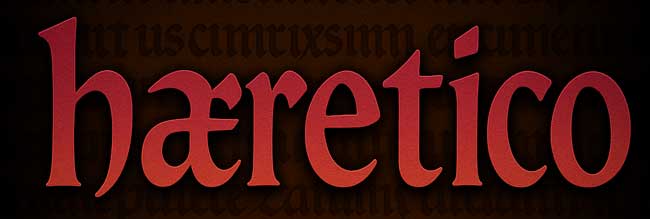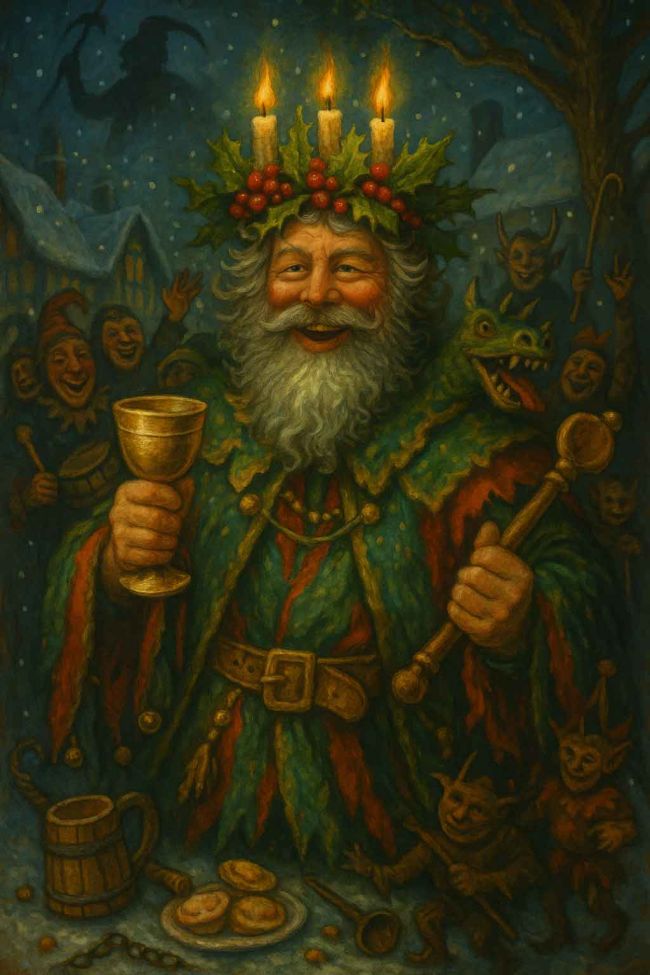Written by David Caldwell ·
The Lord of Misrule: England’s Forgotten Midwinter King
Long before Santa Claus rode in from the North Pole, England had its own spirit of Christmas, a wilder, older, and earthier figure. Known variously as the Lord of Misrule and Father Christmas, he came not to give gifts, but to preside over revelry, feasting, and folly. His origins lie not with saints, but with mummers, ale, and the ancient custom of misrule.
Saturnalia and the Roots of Misrule
The story begins not in England, but in pagan Rome, with the festival of Saturnalia. Celebrated in mid-December, Saturnalia was a time of license and inversion: slaves dined like masters, gambling and drinking were encouraged, and a mock king was elected to preside over the chaos, the King of Saturnalia. This temporary ruler led processions and parody, wielding a mock sceptre, mocking order itself.
It was, as James Frazer argued in The Golden Bough, a sacred inversion, a moment when the world turned upside down before returning to order. This idea of sanctioned disorder travelled north, morphing through the centuries into the English figure of the Lord of Misrule.
The Lord of Misrule in Medieval and Tudor England
From the Middle Ages through to the Reformation, the Lord of Misrule was a fixture in English Christmas. Appointed by noble households, colleges, guilds, and even monasteries, he ruled the revels from All Hallows Eve to Twelfth Night. Known in Scotland as the Abbot of Unreason and in France as the Abbas Stultorum, he presided over masquerades, games, and parodic rituals.
In one colourful description, a Misrule parade included hobby horses, dragons, pipers, and dancers:
"Every one of these men be invested with liveries of green, yellow, or some other light wanton colour... hanged all over with gold rings, precious stones, and other jewels... they have their hobby horses, their dragons, and other antiques... then march this heathen company toward the church, their pipers piping, their drummers thundering."
Even cathedrals joined in, appointing Boy Bishops and Monastic Lords of Misrule. The Feast of Fools in France saw clergy singing bawdy songs from the altar. These customs were not just tolerated; they were integral to the season.
Suppression and Survival
But the age of Misrule would not last. The Reformation and rise of Protestant reformers brought moral reform and suspicion of disorder. In 1555, Queen Mary outlawed mock monarchs in London. The Scottish Parliament abolished the Abbot of Unreason. Puritans condemned these rites as pagan and profane.
Yet even as the official Lord of Misrule vanished, his spirit survived in folk drama. In rural England, the role passed to a familiar figure: Father Christmas.
Father Christmas: Mummer, Trickster, King
Long before he was a gift-bringer, Father Christmas was a performer. In 18th- and 19th-century mumming plays, he led the troupe. These plays were rustic theatre: a blend of ritual, satire, and slapstick performed in barns, kitchens, and village halls during the Twelve Days of Christmas.
He was no saint. He banged on doors with pipe and drum, demanding:
"Tis now in the merry time of Christmas, And Christmas draweth near. I hope your pockets are full of money, And your cellars full of beer."
The troupe would perform a rough play, full of mock combat, resurrection, and bawdy jokes. Heroes like St. George fought Turkish Knights and Giants. Doctors cured the dead with a bottle from Spain. Devils and fools danced. And through it all, Father Christmas presided, half master of ceremonies, half shadow king.
A Shadow of Saturn
This was not Santa Claus. This was a folk trickster, a reminder that midwinter is not just about giving, but surviving. In traditions recorded in Bo'ness, Falkirk, Devon, Somerset, and beyond, Father Christmas knocks at your door not to reward, but to demand.
He was not alone. The entire troupe, often including a devil, a doctor, and a fool, reflected ancient cycles of death and rebirth, chaos and renewal. The performance was both entertainment and ancient ritual.
One striking memory from the Isle of Skye in 1885 describes:
"The servant is free from his master, and each evening of the week is spent in amusements."
In Basingstoke, a Christmas ball welcomed Father Christmas with gusto. In Folkestone, fishermen held a "Rumbald" feast. These are the last flickers of the old Misrule.
The Sherry and Mince Pie
Today, children leave out a glass of sherry and a mince pie for Father Christmas. This quaint ritual may trace back to the mummers, who expected payment in drink or coin for their performance. Their chants were both blessing and threat: give freely, or risk bad luck.
The modern Santa asks politely. The old Father Christmas banged on your door, led a band of masked rogues, and demanded wassail.
From England to America: The Rise of Santa Claus
The modern image of Santa Claus derives from St. Nicholas, the 4th-century Bishop of Myra. But in England, St. Nicholas was almost unknown until the mid-19th century. It was only after the success of Clement Clarke Moore’s poem, "A Visit from St. Nicholas" (1823), and the popularity of imported Christmas cards, that Santa began to replace Father Christmas.
Santa came from America with a sleigh, reindeer, and a North Pole address. He was domesticated: generous, jolly, and harmless. The Lord of Misrule became a saint, and the chaotic mummer was buried beneath red velvet and jingling bells.
A Spirit Not Quite Gone
Yet the Lord of Misrule has not vanished entirely. He lingers in Punch and Judy, in Morris dancing, in the Green Man, and the laughter of village fêtes. He survives in theatre, satire, and the queasy thrill of Carnival.
The poet Isabel Wyatt, channelling Alfred Noyes, gave him voice:
“Like a sunlit sea-wave, A green and crimson sea-wave, A frolic of madcap May-folk Came whooping through the door.”
He is:
- The bearded old man of the solstice
- The crowned fool of the manor
- The drunken guest demanding ale
- The shadow of Saturn
He reminds us that Christmas was once a time of chaos before order, fear beside laughter, and feast beside famine. He was not respectable. And that, perhaps, is why he mattered.
This winter, leave him a glass of sherry. Just in case he knocks.
A Concluding Reflection: Dickens and the Three Spirits
Charles Dickens may have understood more than anyone how Christmas was changing. Born in 1812, he grew up in a world of Father Christmas, wassailing, and rural festivity — but by the time he reached adulthood, these customs were fading. His 1842 visit to New York exposed him to an America already inventing its own version of the holiday, with Saint Nicholas, stockings, and sleighs. That winter was bitterly cold and snow-covered, a true American white Christmas. Dickens noted the intense cold and snowy landscapes of Boston and New York, which contrasted with the often mild and wet English Decembers.
Snow at Christmas was, in many ways, an American invention , and one more tradition imported back across the Atlantic.
One year later, A Christmas Carol appeared. In it, the three ghosts, Past, Present, and Future, seem to embody not just Scrooge’s life, but three versions of Christmas itself.
The Ghost of Christmas Present bears a particularly strong resemblance to the old English Father Christmas. He is described as a jovial giant, robed in green and fur, with a wreath of holly on his head, a bare chest, and a seat upon a throne of food and drink. He embodies the generosity and theatricality of the Lord of Misrule, blessing the poor, exposing hypocrisy, and revealing the warmth of community.
The Ghost of Christmas Past, while more ethereal and childlike, symbolises a nostalgic, glowing memory of the holiday, perhaps reflecting Dickens’s own recollections of early 19th-century traditions. The Ghost of Christmas Yet to Come casts a shadow of warning: a future in which Christmas may be forgotten, commercialised, or emptied of meaning.
Through these spirits, Dickens was not only reviving Christmas, he was documenting its transformation, preserving the folk roots of the festival even as it evolved under the pressure of industrialisation, Americanisation, and moral reform. He saw what was being lost, and tried to keep its spirit alive, not just for Scrooge, but for England.
Related Articles
4 October 2025
The Ancient Blood: A History of the Vampire27 September 2025
Epona: The Horse Goddess in Britain and Beyond26 September 2025
Witchcraft is Priestcraft: Jane Wenham and the End of England’s Witches20 September 2025
The Origins of Easter: From Ishtar and Passover to Eggs and the Bunny12 September 2025
Saint Cuthbert: Life, Death & Legacy of Lindisfarne’s Saint7 September 2025
The Search for the Ark of the Covenant: From Egypt to Ethiopia5 September 2025
The Search for Camelot: Legend, Theories, and Evidence1 September 2025
The Hell Hound Legends of Britain25 August 2025
The Lore of the Unicorn - A Definitive Guide23 August 2025
Saint Edmund: King, Martyr, and the Making of a Cult14 August 2025
The Great Serpent of Sea and Lake11 August 2025
The Dog Days of Summer - meanings and origins24 June 2025
The Evolution of Guardian Angels19 June 2025
Dumnonia The Sea Kingdom of the West17 June 2025
The Roman Calendar, Timekeeping in Ancient Rome14 June 2025
Are There Only Male Angels?
